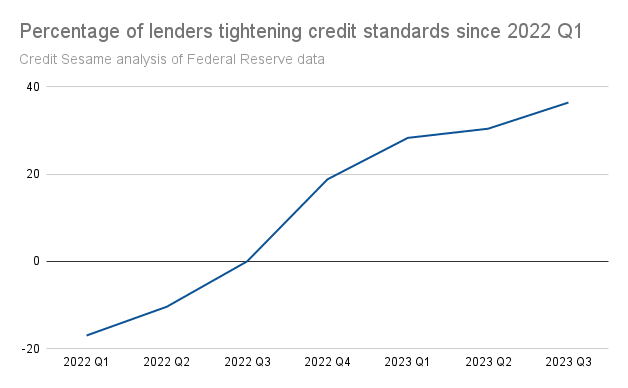Credit Sesame discusses what tighter credit standards mean for consumers.
A good credit score is always valuable. It can make it easier to get credit and less expensive to use credit. In mid-2023, good credit is more than just a nice thing to have. Trends in banking mean good credit is a must if you want the convenience of a credit card or the opportunity to buy a home with a mortgage.
Banks are tightening their credit standards, which means they are pickier about who they lend to. That means a good credit score plays a bigger role in whether you are approved for credit or get a reasonable interest rate. If there was ever a time to work on improving your credit, now is that time.
What are credit standards?
Credit standards are a variety of factors lenders use to decide whether it’s worth the risk of lending to an applicant. They can include a variety of things, such as:
- Credit score
- Debt-to-income ratio
- Loan-to-value ratio
- Job history
Your credit score may affect whether you get approved for a loan at all, the size of the loan and the down payment required. Lenders also use credit standards to determine the interest rate they charge. From the lender’s perspective, a higher interest rate can help make a riskier loan worthwhile. Someone with a lower credit score is likely to be offered a higher interest rate.
Loan officers don’t look at any one of these factors in isolation. They may consider trade-offs between different factors. A loan officer may approve a loan to someone with a slightly lower credit score as long as they have a better debt-to-income or loan-to-value ratio. However, ensuring you have a good credit score takes one negative factor out of the equation.
How are lenders changing credit standards?
Credit standards change over time, depending on economic conditions and the financial health of banks. Changes in credit standards can make it easier or harder for consumers to secure credit and loans.
Recent trends indicate that lending standards are tightening. The Federal Reserve conducts a quarterly survey of senior loan officers. Among other things, it asks the loan officers whether their bank is loosening or tightening standards. The Federal Reserve calculates the net percentage that tightens standards. This is a good indicator of the general lending environment. If more loan officers tighten standards than loosen them, the net percentage is positive. That means it is tougher to get a loan. When the percentage tightening standards is negative, it means lending standards are generally getting easier. This is how credit standards have changed since the start of 2022.

In early 2022, lending standards were loosening, meaning it was easier to get a credit card. This has drastically reversed course in recent months. Increasingly, more lenders have tightened standards. That means it has become tougher to get a credit card. This trend is also reflected in lending standards for consumer loans. Clearly, the current environment is making lenders more cautious.
Why are credit standards getting tougher?
Here are three big reasons lenders are more hesitant to make loans these days:
- Debt levels are at record highs. The Federal Reserve Bank of New York recently reported that overall consumer debt has reached an all-time high of $17.06 trillion. Credit card debt has reached the $1 trillion mark for the first time ever. In short, consumers already carry a substantial debt burden.
- Missed payments. The New York Fed found that the percentage of seriously late (90+ days) payments has risen for mortgages, auto loans, and credit cards over the past year. Consumer credit default rates are up over the past year, especially for credit cards.
- Bank failures. Regulators have announced plans to increase reserve requirements for banks in response to bank failures earlier this year. This would restrict the amount of money banks have available to lend.
None of the above means that banks will stop lending money. It just means they will become choosier about who they lend to. The New York Fed’s Survey of Consumer Expectations found that rejection rates on credit applications recently hit a five-year high.
Rejection rates have risen sharply for people with credit scores of 680 or lower. More than half of applicants with credit scores of 680 or lower are now being rejected. Significantly, over the same period rejection rates have not risen for people with good or excellent credit.
What can you do about it?
Conditions dictate that this would be a good time to work on improving your credit score. There are a variety of things you can do to make this happen.
Payment history is the largest single factor in determining credit score. Getting a line of credit that can help you establish a positive payment history would be a big step towards better credit. However, with tighter credit standards it has become harder to get credit in the first place.
You can get a secured credit card without having great credit, but this requires a security deposit that is not available for you to spend. This may not be an option for households short on cash.
One answer could be a card with no up front security deposit that doesn’t require great credit. For example, the Sesame Cash account with Credit Builder. This secured credit card helps you build credit with debit and can help you build payment history. In turn, this can have a positive effect on your credit score. The higher you can build your score, the better your position for getting a loan in the future.
Tighter credit standards are cutting down the financial options available to millions of consumers. If you don’t want your financial flexibility to become even more limited, working on your credit score is the best way to respond.
If you enjoyed Tighter credit standards make good credit more important, you may like,
- Build credit with debit using Sesame Cash with Credit Builder
- Is a good credit score key to peace of mind?
- Why credit building just got more important
Disclaimer: The article and information provided here is for informational purposes only and is not intended as a substitute for professional advice.
Sesame Cash is a prepaid debit card issued by Community Federal Savings Bank (CFSB). Building credit with Sesame Cash requires you to also open a secured line of credit with CFSB that is reported to the credit bureaus. Use money from your Sesame Cash account to create a secured line of credit (Secured Account). Your debit card purchases are then added up to create a balance on your Secured Account. As you make these purchases, an amount equal to the balance on your Secured Account is also set aside in your Sesame Cash account to ensure you can make timely payments to pay off the balance on your secured line of credit at the end of each month, allowing you to build a positive payment history. Credit Sesame does not guarantee credit score improvement. Any predicted credit improvement from the use of your Secured Account assumes that you will maintain healthy credit habits, including paying bills on time, keeping credit balances low, avoiding unnecessary inquiries, appropriate financial planning, and more.





















